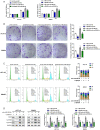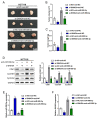lncRNA SNHG4 modulates colorectal cancer cell cycle and cell proliferation through regulating miR-590-3p/CDK1 axis
- PMID: 33744866
- PMCID: PMC8064176
- DOI: 10.18632/aging.202737
lncRNA SNHG4 modulates colorectal cancer cell cycle and cell proliferation through regulating miR-590-3p/CDK1 axis
Abstract
Colorectal cancer (CRC) is a prevalent malignancy worldwide. The development of genome sequencing technology has allowed the discovery that epigenetic regulation might play a critical role in CRC tumorigenesis. In the present study, we found that the long noncoding RNA (lncRNA) SNHG4 was dramatically increased in CRC tissue samples and cell lines based on both publicly available and experimental data. SNHG4 knockdown suppressed the viability and colony formation capacity of CRC cells. The expression of CDK1 was considerably increased in CRC tissue samples and cells and had a positive correlation with the expression of SNHG4 in CRC. SNHG4 silencing not only caused S phase cell cycle arrest but also significantly downregulated the CDK1, cyclin B1, and cyclin A2 protein levels in CRC cells. miR-590-3p simultaneously bound to SNHG4 and CDK1. miR-590-3p functioned to inhibit CDK1 expression. miR-590-3p overexpression exerted the same effects on the CRC cell phenotype as SNHG4 knockdown. The effects of si-SNHG4 on CRC cells were significantly reversed by anti-miR-590-3p, indicating that SNHG4 relieved the miR-590-3p-induced inhibition of CDK1 by acting as a competing endogenous RNA (ceRNA). In vivo, SNHG4 silencing inhibited subcutaneously transplanted tumor growth and decreased cell cycle marker levels, whereas miR-590-3p inhibition exerted the opposite effects. The in vivo effects of SNHG4 silencing were also reversed by miR-590-3p inhibition. The SNHG4/miR-590-3p/CDK1 axis influences the cell cycle to modulate CRC cell proliferation and subcutaneously transplanted tumor growth. Further application of this axis still requires analysis using more animal models and clinical investigations.
Keywords: CDK1; cell cycle; colorectal cancer (CRC); lncRNA SNHG4; miR-590-3p.
Conflict of interest statement
Figures








Similar articles
-
LncRNA SNHG4 promotes tumour growth by sponging miR-224-3p and predicts poor survival and recurrence in human osteosarcoma.Cell Prolif. 2018 Dec;51(6):e12515. doi: 10.1111/cpr.12515. Epub 2018 Aug 28. Cell Prolif. 2018. PMID: 30152090 Free PMC article.
-
Knockdown of long noncoding RNA PVT1 suppresses cell proliferation and invasion of colorectal cancer via upregulation of microRNA-214-3p.Am J Physiol Gastrointest Liver Physiol. 2019 Aug 1;317(2):G222-G232. doi: 10.1152/ajpgi.00357.2018. Epub 2019 May 24. Am J Physiol Gastrointest Liver Physiol. 2019. PMID: 31125260
-
The lncRNA XIST/miR-125b-2-3p axis modulates cell proliferation and chemotherapeutic sensitivity via targeting Wee1 in colorectal cancer.Cancer Med. 2021 Apr;10(7):2423-2441. doi: 10.1002/cam4.3777. Epub 2021 Mar 5. Cancer Med. 2021. PMID: 33666372 Free PMC article.
-
MiR-29a-3p: a potential biomarker and therapeutic target in colorectal cancer.Clin Transl Oncol. 2023 Mar;25(3):563-577. doi: 10.1007/s12094-022-02978-6. Epub 2022 Nov 10. Clin Transl Oncol. 2023. PMID: 36355327 Free PMC article. Review.
-
The Regulatory Mechanisms and Clinical Significance of Lnc SNHG4 in Cancer.Curr Pharm Des. 2022;28(44):3563-3571. doi: 10.2174/1381612829666221121161950. Curr Pharm Des. 2022. PMID: 36411578 Review.
Cited by
-
Zebrafish xenograft model for studying the function of lncRNA SNHG4 in the proliferation and migration of colorectal cancer.J Gastrointest Oncol. 2022 Feb;13(1):210-220. doi: 10.21037/jgo-21-832. J Gastrointest Oncol. 2022. PMID: 35284103 Free PMC article.
-
The siRNA-mediated knockdown of SNHG4 efficiently induced pro-apoptotic signaling and suppressed metastasis in SW1116 colorectal cancer cell line.Mol Biol Rep. 2023 Nov;50(11):8995-9006. doi: 10.1007/s11033-023-08742-5. Epub 2023 Sep 16. Mol Biol Rep. 2023. PMID: 37715875
-
From cell cycle control to cancer therapy: exploring the role of CDK1 and CDK2 in tumorigenesis.Med Oncol. 2025 Aug 9;42(9):422. doi: 10.1007/s12032-025-02973-1. Med Oncol. 2025. PMID: 40782258 Review.
-
Overall Survival Signature of 5-Methylcytosine Regulators Related Long Non-Coding RNA in Hepatocellular Carcinoma.Front Oncol. 2022 May 24;12:884377. doi: 10.3389/fonc.2022.884377. eCollection 2022. Front Oncol. 2022. PMID: 35686101 Free PMC article.
-
SNHG4-mediated PTEN destabilization confers oxaliplatin resistance in colorectal cancer cells by inhibiting ferroptosis.Apoptosis. 2024 Jun;29(5-6):835-848. doi: 10.1007/s10495-024-01948-3. Epub 2024 Apr 4. Apoptosis. 2024. PMID: 38573492
References
Publication types
MeSH terms
Substances
LinkOut - more resources
Full Text Sources
Other Literature Sources
Medical
Miscellaneous

